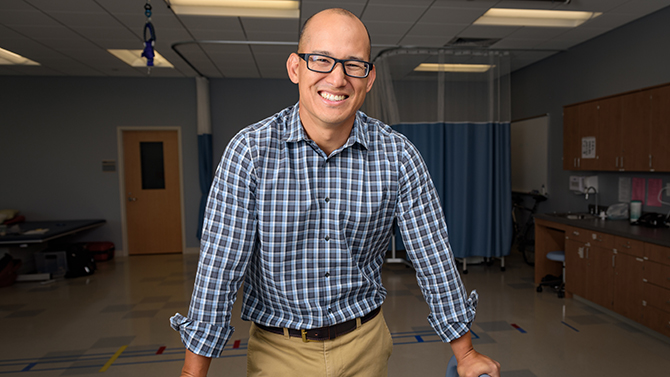


Physical activity party
Photo by Evan Krape August 31, 2016
White wants health professionals to invite patients to 'physical activity party'
Weight control, reduced risk of cardiovascular disease, stronger bones, stronger muscles, improved mood – the benefits of physical activity are many, yet it is the most underutilized intervention by health professionals, which is somewhat surprising.
Regular activity is helpful to everyone and the value is particularly beneficial for people with chronic diseases. Just ask Daniel White, assistant professor of physical therapy in the University of Delaware’s College of Health Sciences.
“People with chronic illness are commonly seen by rehabilitation professionals. We need to be promoting this, but I don’t think we are,” said White. “Unfortunately, the approach is ‘fix the pain and move on.’”
And that approach is missing a major opportunity. The single most important determinant of someone starting to exercise is a health professional’s recommendation.
“It’s not like we need to bend over backwards to get these people active; it’s just saying something,” White said.
Yet, only three out of 10 physicians recommend exercise for people with chronic diseases. White points to knee osteoarthritis, degenerative arthritis of the knee, as example A.
“Not recommending exercise [for these knee issues] is terrible,” he said. “It’s a clinical practice guideline to recommend exercises and the message is not getting to the patient. Unfortunately, it’s not a priority. That’s a huge missed opportunity.”
With many more of these frustrating cases from around the world of health care, White had the idea to put together a special journal issue devoted to physical activity on rehabilitation populations.
He worked with researchers across the country, collecting papers that target physical activity in patient populations commonly seen by rehabilitation professionals. The idea was realized in “Physical Activity in Adult Rehabilitation Populations,” a supplement to the Archives of Physical Medicine and Rehabilitation.
White is an editor, organizer and author. He also wrote a special communication at the beginning of the issue that’s appropriately titled, “It Is Time to Invite Patients to the Physical Activity Party.”
“That message of physical activity needs to be clear to our patients and clients,” White said. “One of the criticisms of rehabilitation is people prescribe exercise for exercise’s sake. But, to be quite honest, no one likes to do exercise. Rather, let’s identify and start with activities that the individual likes to do.”
Whether they’re in a rehab setting or not, White wants people to think about the entire the physical activity spectrum from dancing to going on a walk to playing Pokémon Go – and, yes, studies are in the works.
“It’s the nudge principle. There are small suggestions that we can make to people that will make big differences,” White said. “That includes actively following up with patients.”
White also co-authored one of the issue’s original research articles with UD’s Gregory Dominick, assistant professor of behavioral health and nutrition, and Joseph Zeni, assistant professor of physical therapy.
The exploratory study investigates the association of psychosocial factors with physical activity and function after a total knee replacement.
The issue also features original research from the College of Health Sciences’ Kelly Danks, Ryan Pohlig and Darcy Reisman. The trio examined fast-walking training and a step activity monitoring program to improve daily walking in people who’ve had a stroke.
Other populations that need an invitation to the physical activity party include those with traumatic brain injury, spinal cord, diabetes, older adults in a geriatric rehab setting and even former athletes who sustain injuries early in life.
So many of these groups see a physical therapist or another health professional on a regular basis. But, is there a physical activity conversation taking place? In too many cases, it is not.
“These conversations can sow the seeds for the future,” said White. “It could be the difference in someone being overweight, obese, having multiple joint replacements versus living an active lifestyle, being healthy and minimal comorbidity.”
Contact Us
Have a UDaily story idea?
Contact us at ocm@udel.edu
Members of the press
Contact us at 302-831-NEWS or visit the Media Relations website

